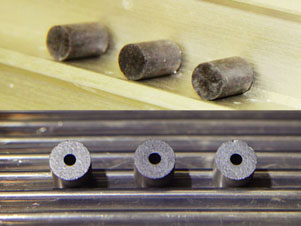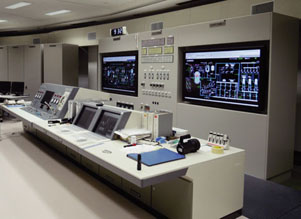Tsuruga Head OfficeThe “MONJU” System Start-up Tests (SST) were restarted in May 2010 and the Core Confirmation Tests (CCT) that constitute the first stage in the third stage of the SST were completed in July 2010. Although the drop of the In-Vessel Transfer Machine (IVTM) occurred after refueling in August 2010, we completed the withdrawal of IVTM on June 24, 2011. We are currently performing the integrity evaluation of the IVTM on the basis of the results of the overhaul inspection. In addition, following the accident at the Tokyo Electric Power Company, Incorporated Fukushima Daiichi Nuclear Power Station, safety measures are being implemented. The “FUGEN” Decommissioning Engineering Center steadily conducts decommissioning. We launched an open-type business in 2010 with the aim to cooperate with local industries in Fukui Prefecture in finding solutions for research challenges facing JAEA in.
|
・ The facilities important for safety, including sodium systems, are located 21 m above sea level, and seawater pumps for cooling are surrounded by waterproof walls that offer protection against tsunamis.
・ The integrity of reactor cooling systems against earthquakes has been reaffirmed by a seismic safety estimation based on the new guideline.
・ Stainless steel is used for the cladding material, and therefore, there is no production or explosion of hydrogen.
Safety design of“MONJU” |
Tokai Research and Development Center, Nuclear Science Research Institute (NSRI)Research reactors (JRR-3, JRR-4, NSRR), accelerators (Tandem etc.), critical assemblies (STACY, FCA, etc.), and hot laboratories (WASTEF, BECKY, etc.) have been operated for R&D activities of the research directorates of JAEA. An innovative technique for the replacement of panels of a large glove box for safely handling radioactive materials was developed in order to reduce the cost and labor for the maintenance of glove boxes (Referred to Topic 12-2). This year the Minister of Education, Culture, Sports, Science and Technology awarded a prize for great originality in science and technology to this technical development. A mirror enabling the supply of high-intensity cold neutron beams was designed at JRR-3. High-quality monoenergetic neutron reference fields were developed so that the technology base for utilizing neutrons can be reinforced. Furthermore, manufactures employed electronics technologies developed at NSRI and X-ray diagnostics to produce a new measuring instrument-a very-high-accuracy X-ray fluorescence analyzer.
|
Main research facilities at Nuclear Science Research Institute |
Tokai Research and Development Center, Nuclear Fuel Cycle Engineering LaboratoriesAt the Plutonium Fuel Development Center, engineering scale tests associated with the fabrication of annular mixed oxide (MOX) pellets and oxygen-to-metal ratio (O/M) adjustment are being carried out to develop the fuel fabrication process named the “Simplified MOX Pellet Fabrication Process”(Topic 12-4). Fifteen fuel assemblies fabricated by the pellets obtained from the test were supplied to “MONJU” for use in its plant performance test. At the Reprocessing Technology Development Center, seismic reinforcement of Tokai Reprocessing Plant is being carried out. Technical cooperation with the Japan Nuclear Fuel Limited (JNFL), which includes supporting the active test of the Rokkasho Reprocessing Plant (RRP) and training JNFL’s engineers, is also carried out. Various other research and development (R&D) activities, such as advanced reprocessing by using an aqueous method (Topic 12-3) and geological disposal technologies, are being conducted. Additionally, the safety design of an incineration facility for radioactive waste treatment was discussed. |
 Appearances of sintered annular MOX pellets (under development) |
J-PARC CenterDuring the Japanese fiscal year 2010, the intensity of the proton beam delivered to the Materials and Life Science Experimental Facility (MLF) was increased from 120 kW to 200 kW, as planned, and the acceleration test with the 420 kW equivalent beam was also successfully carried out. The intensities of the proton beams to the Nuclear and Particle Experimental Facility and to Neutrino Experimental Facility (NU) were increased up to 3.6 kW and 145 kW, respectively. For the MLF user program, 350 proposals were accepted, which was a 35% increase from the number of proposals accepted in the fiscal year 2009. Moreover, the events indicating the oscillation from muon neutrinos to electron neutrinos were detected for the first time in the world at the Super-Kamiokande detector in Kamioka in Gifu Prefecture situated 295 km away from J-PARC where the muon neutrinos were produced. The annual duration of the operation of J-PARC was about 120 days in which the cumulative neutron-production duration exceeded 2300 h. Users utilized the MLF and NU for 5000 and 16000 person-days, respectively, before the operation was terminated by The Great East Japan Earthquake on March 11, 2011. |
Installation of vacuum chamber for neutron instrument BL15 in Materials and Life Science Experimental Facility. BL15 is the first instrument for public utilization in MLF constructed in accordance with the Law for Promotion of Public Utilization of the Specific Advanced Large Research Facilities. |
Oarai Research and Development CenterExperiments such as post-irradiation examinations of FBR high burn-up fuels and minor actinide-containing fuels, and sodium tests, were conducted for the Fast Reactor Cycle Technology Development (FaCT) Project. Moreover, construction of the Advanced Technology Experimental Sodium facility (AtheNa) for coolant system equipment as the demonstration plant continued. In the Japan Materials Testing Reactor (JMTR), refurbishment work on a cooling system and of an instrumentation and control system for JMTR restart has been completed. The International Symposium on Material Testing Reactors was held with the aim to exchange information and hold discussions on topics related to international standard technology. In the experimental fast reactor Joyo, detailed design of equipment for the recovery of an obstacle on the in-vessel storage rack and of an exchange equipment of upper-core structure were carried out. In the High Temperature Engineering Test Reactor (HTTR), performance data for basic technology establishment and commercialization of high-temperature equipment were obtained through a loss-of-core-flow test for safety demonstration. |
 Renewed instrumentation and control system in JMTR control room |
Naka Fusion InstituteNaka Fusion Institute promotes research and development for realizing the practical use of fusion energy. It is now acting as a domestic agency of the International Thermonuclear Experimental Reactor (ITER) project, and it is mainly involved in the procurement and development of the JA-shared apparatuses. Further, in cooperation with EU, as Broader Approach (BA) activities, the institute is working on the upgrade of the large tokamak device JT-60 to a satellite tokamak device (JT-60SA)that will be used in studies supporting and complementing the ITER project. In 2010, disassembly of JT-60 was fully started, and it is in progress. Further, the removal of the tokamak auxiliary devices such as the measurement devices, plasma-heating devices, gas-injection device, and platform for measurement devices was carried out. In addition, the removal of approximately 12,000 pieces of the first-wall tiles in the vacuum vessel was completed. The fabrication for JT-60SA and the procurement of the superconductor to use for the magnetic field coil of real machine in our site have also been continued. On the basis of the experiences in the manufacturing of the prototype, the fabrication of the vacuum vessel was started. |
Main part of JT-60 under the disassembly work (March 2011) |
Takasaki Advanced Radiation Research InstituteTakasaki Ion Accelerators for Advanced Radiation Application (TIARA), consisting of four ion accelerators, an electron accelerator, and gamma irradiation facilities at the JAEA’s Takasaki Advanced Radiation Research Institute, are available to researchers in JAEA and other organizations for performing R&D activities on new functional and environmentally friendly materials, biotechnology, radiation effects of materials, and quantum beam analysis. Practical technology-development activities related to the following are in progress: microbeams, single ion hits, and techniques for uniform wide-area irradiation at a cyclotron, and three-dimensional in-air PIXE analysis and three-dimensional microbeam writing technology with different energy proton beams at the electrostatic accelerators. In 2010, the development of a beam-formation technique was started, which will provide a wide and uniform beam of heavy ions of several hundreds of megaelectronvolt. A chamber was designed and installed in the beam line of the AVF cyclotron for this purpose (Topic 12-10). |
Chamber installed in the LB course of the AVF cyclotron for formation of wide and uniform beam irradiation area |
Kansai Photon Science InstituteIn the Kizu District, we are improving laser facilities, e.g., the improvement in the quality of a high-intensity laser. In addition, we are developing “High Quality Ultra Advanced Radiation Sources” (QUADRA) in the Consortium for Photon Science and Technology (C-PhoST) as a managing institution. In the Photo-Medical Research Center, we have developed elemental technologies for a laser-driven particle accelerator. In the Harima District, we have been developing and improving a state-of-the-art measurement technique using intense X-rays at four JAEA beamlines at SPring-8, the world’s largest synchrotron radiation facility. In addition, we have also been conducting material science research related to energy and environment, including actinide compounds, which are important in nuclear energy development and all related research, using the JAEA beamlines. |
JAEA Kansai Advanced Relativistic ENgineering (J-KAREN) laser system |
Horonobe Underground Research CenterAt the Horonobe Underground Research Center, we are utilizing the underground facilities for promoting an underground research laboratory project for “geoscientific research” and “research and development of a geological disposal technology” suitable for sedimentary rocks. As part of the geoscientific research, we continuously carried out the following: development of techniques for investigating the geological environment, development of techniques for long-term monitoring of the geological environment, development of engineering techniques for use in the deep underground environment, and studies on the long-term stability of the geological environment. Further, as part of the research and development of a geological disposal technology, we investigated the effect of low-alkaline cement (Highly Fly-ash Contained Silica-fume Cement) on the surrounding groundwater and rock mass in the 140-m-depth gallery. In order to continue the project efficiently, we introduced the Private Finance Initiative (PFI) in January 2011. |
West Access Shaft (photo 2011.6.1) |
Tono Geoscience Center (TGC)The TGC’s task is to provide the scientific and technical foundations for developing a safe technique for the geological disposal of high-level radioactive waste. This involves research on the long-term stability of the geological environment, and research on the development and improvement of techniques for the characterization of the deep geological environment and a wide range of engineering techniques for deep underground applications at an underground research laboratory in crystalline rock, referred to as Mizunami Underground Research Laboratory (MIU). As of March 2011, the Main and Ventilation Shafts had reached GL -481.3 m and -497.7 m (meters below ground level) (Topic 12-11). Research and development activities, such as geological mapping during excavation and borehole investigations at the stages at GL -300 m and -400 m, were carried out.
|
View of the Main Shaft at GL -480 m |
Ningyo-toge Environmental Engineering CenterAt the Ningyo-toge Environmental Engineering Center, many of the centrifuges that were tested for enrichment are kept in the facility. We are working on the dismantling and decontamination of these centrifuges. It is necessary to dispose them efficiently. Therefore, some tests were conducted in collaboration with the relevant division and company.: |
Measurement principle
The ion ionized by the α-ray is transported by the airflow, and the current measured with the ion sensor is converted into radioactivity Conceptual diagram of α radiation measurement technology with ionized-air-type measurement |
Aomori Research and Development CenterIn the Rokkasho district, the use of radioisotopes in the demo R&D building is expected to be allowed by the authorities in FY2011, and now preparation for the full-scale operation of the building as one of three research facilities for the BA activities is now in progress. The computational simulation center (CSC) is also preparing for the installation of the super computer (created by Bull, France) whose operation is slated to start in FY2011. In the Mutsu district, the following are being simultaneously carried out: (1) A research survey is being conducted to develop a reasonable/economical large-assembly-dismantling methodology for operating a waste disposal plant to be used by research facilities and for decommissioning the nuclear-powered ship Mutsu; this methodology would include the survey of the contaminants. (2) A technology for analyzing ultratrace elements using accelerator mass spectrometry (AMS) is being developed. |
The super computer that is advancing installation |